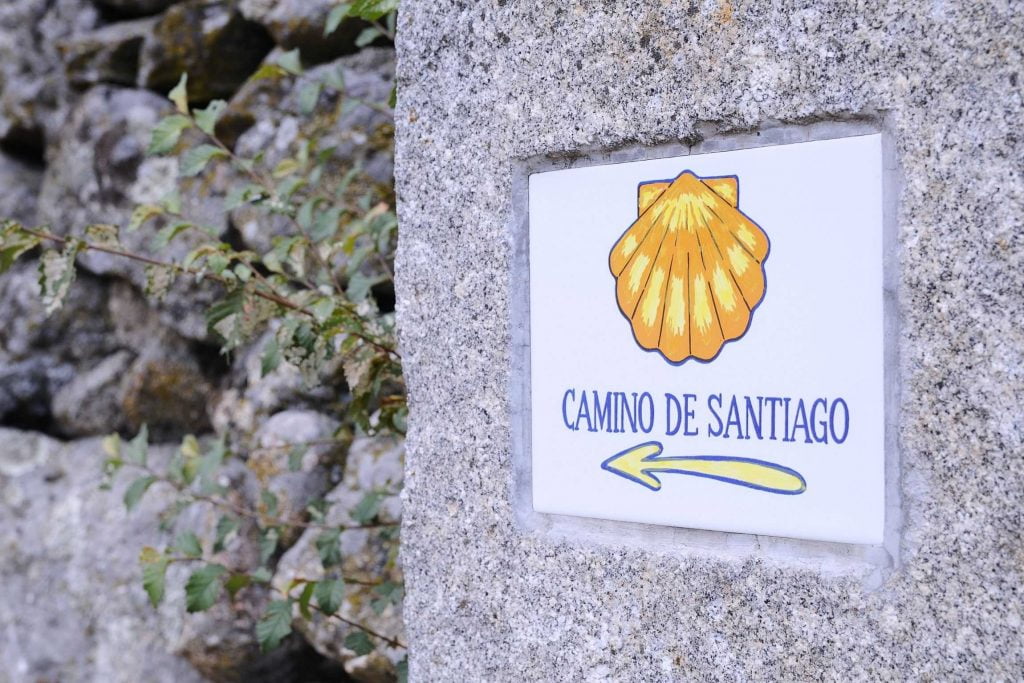Pilgrims from all corners of the world have travelled to Santiago de Compostela over hundreds of years. As a result, different Camino traditions, rituals and customs have emerged, some of them as old as the Camino itself:

THE SCALLOP SHELL
Carrying a scallop shell during your journey or getting one once you reach Santiago is one of the oldest Camino traditions. The Scallop shell or Pilgrim Shell is the most iconic symbol of the Camino, representing Camino pilgrims the world over.
You can read more about the origin of this Camino tradition on our blog post about the Camino Shell.
STAMPING YOUR PILGRIM PASSPORT
Carrying a pilgrim passport that identifies you as a Camino pilgrim might be a more contemporary tradition but a very important one.
The pilgrim passport will need to be stamped regularly along the way in order to prove that you have completed the required distance to obtain a Compostela pilgrim certificate at the Pilgrims Office.
For those staying in public ‘albergues’ (hostels), the pilgrim passport with its stamps is required in order to stay as guests for the night, generally giving preference to those walking.
PILGRIM GREETINGS
Pilgrims along the Camino de Santiago greet each other and are greeted with a Buen Camino (in Spanish), Bon Camino (in Galego) or Bom Caminho (in Portuguese).
There is also another traditional Camino greeting: ‘Ultreia!’ to which you must reply ‘et Suseia’, onwards and upwards. While it is difficult to know exactly when this expression started to get used, it is believed to have been in use since the 12th century, when the Codex Calixtinus was published.
‘Ultreia’ is a means of encouraging other pilgrims to go ‘beyond’, to continue ahead. These pilgrim greetings are one of our favourite Camino traditions.
CRUZ DE FERRO – IRON CROSS
The Iron Cross in the Mountains of Leon, Cruz de Ferro, is a special place for many pilgrims; where they stop to reflect on their journey.
There are different theories about the origin of the Cruz de Ferro. Traditionally, pilgrims would carry a stone from their home place so they could leave it at the Cruz de Ferro, as a symbol of their sins; or pick a stone at the cross to bring it home.
HOLY DOOR IN SANTIAGO AND VILLAFRANCA
The Holy Door in Santiago de Compostela Cathedral is open to pilgrims only on Holy Years, when 25th July Saint James Day falls on a Sunday. This is an entrance that takes visitors to the back of the Main Altar and the crypt with the sepulchre of St James.
The mountain village of Villafranca del Bierzo on the Camino Frances also has its own ‘Holy Door’ and pilgrims can also get a plenary indulgence there if they are unable to continue their journey. This is the reason Villafranca is sometimes known as ‘Little Compostela’.
In order to receive a plenary indulgence on a Holy Year, pilgrims must visit the tomb of the Apostle, go to confession and communion and say a prayer.
EMBRACING ST JAMES THE APOSTLE
At the back of the Main Altar in Santiago de Compostela Cathedral, the figure of Saint James the Apostle reigns over the temple. Pilgrims and visitors can walk up to the figure to embrace the Apostle and offer them the following words:
“Thank you my friend Saint James, brother Saint James, for helping me to get here! Thank you for your company, for your testimony and your legacy!”
After the embrace, most pilgrims walk down to visit the crypt and tomb of Saint James, below the Main Altar.

ATTENDING PILGRIM MASS
Pilgrim Mass takes place each day at Santiago de Compostela Cathedral to welcome pilgrims from all over the world who make their way to the city of Saint James. Attending Pilgrim Mass at midday has become a tradition for those on the Camino and in some cases, they will get to see the Botafumeiro in action.
A second Pilgrim Mass takes place in the evenings, generally at 7.30pm and additional services might take place during Holy Year.
PURIFICATION AT THE END OF THE WORLD
There are many Camino traditions, rites and customs associated with purification and Fisterra, which the Romans thought was the ‘End of the World’. Some of them might be of pagan origin.
Watching the sun set over the Atlantic Ocean at Cape Fisterra and going for a swim in the ocean are two of the most special rites for pilgrims here.
In the past, pilgrims also used to burn their clothes at the cape but this practice has been banned as it poses serious risks in terms of health and safety, as well as being harmful to the environment.
We hope you enjoyed our selection of Camino traditions, rituals and customs. Let us know if you know of any other interesting ones.
For more information about our Camino de Santiago tours, or to organise a private group tour contact our knowledgeable travel team.
Contact Us



